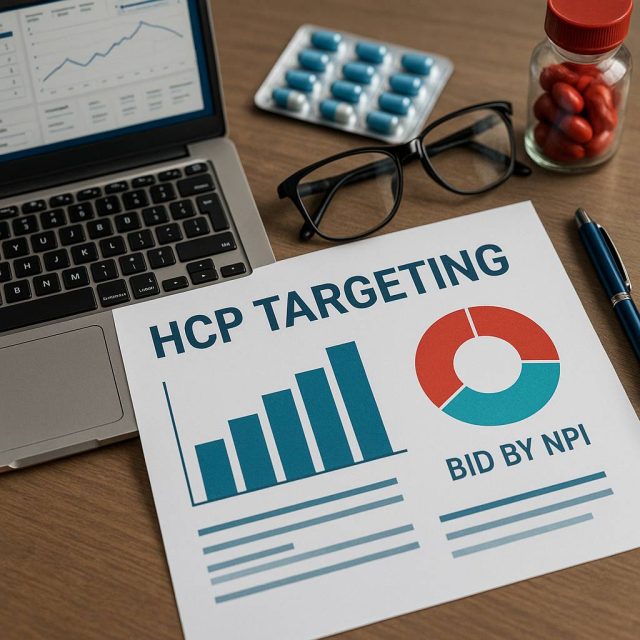In 2015, the idea of targeting individual healthcare professionals (HCPs) through real-time digital bidding felt more like science fiction than strategy. Yet for RJ Lewis, CEO of eHealthcare Solutions and co-founder of Tap Native, it was a logical extension of precision marketing trends emerging in other sectors.
He envisioned a world where pharmaceutical brands could assign value at the individual prescriber level—just as search marketers had long bid on keywords. Now, that vision has arrived.
Introducing Bid-by-NPI: From Segmentation to Personalization
Tap Native has launched the industry’s first “Bid-by-NPI” auction pricing model, allowing pharma marketers to bid individually on HCPs based on their National Provider Identifier (NPI). This innovation enables campaign budgets to reflect the real-world value each HCP brings to a brand—whether measured by prescription behavior, specialty, or patient volume.
Instead of relying solely on blunt segmentation models like decile marketing, pharma advertisers can now implement customized cost-per-click (CPC) strategies by HCP. As RJ Lewis puts it, “Not all physicians are valued the same to all brands, so why pay the same amount for an engagement?”
Breaking the Decile Mold: Targeting with Greater Precision
The Bid-by-NPI model replaces static audience segmentation with a more dynamic, real-time targeting engine. Historically, decile marketing offered a standardized approach to reach high-prescribers—but it failed to account for intra-decile variations in HCP behavior, specialty, and product relevance.
By unlocking prescriber-level granularity, Tap Native empowers pharmaceutical marketers to shift from cohort marketing to personalized engagement. The result? Higher ROI, improved budget efficiency, and more meaningful touchpoints across the HCP journey.
This approach aligns with broader shifts in digital healthcare marketing—where scale still matters, but personalization defines success.
AI + PLD: Personalization at Scale
In a recent DHC Group interview, RJ Lewis expanded on the three strategic pillars behind the Bid-by-NPI rollout:
- Real-time physician-level data (PLD)
- One-to-one bidding at the NPI level
- AI-powered creative generation
These components are helping pharma brands push past one-size-fits-all messaging. AI is playing an increasing role not just in targeting but in content creation—fueling dynamic creative that adapts to specialty, channel behavior, and prescribing patterns.
Marketers can now combine insights from PLD with AI-driven segmentation to generate audience-specific messaging at scale. The result is not just better performance—but more relevance in every interaction.
Implications for Pharma Marketers
The Bid-by-NPI model gives pharmaceutical advertisers new capabilities to optimize both strategy and spend:
- Value-based targeting: Identify high-impact HCPs by NPI and adjust CPC bids accordingly.
- Budget efficiency: Spend more effectively by aligning bids to real-world prescribing data.
- Abandon outdated segmentation: Move beyond decile-level guesswork to real-time, one-to-one HCP engagement.
- Massive reach: Deliver targeted campaigns across 82% of the open web, while maintaining control over who sees each message.
For marketing leaders focused on improving omnichannel performance and demonstrating measurable business value, Bid-by-NPI offers a significant leap forward.
Looking Ahead: Regulatory Alignment and Future Opportunity
In the same interview, RJ noted that regulatory factors such as MLR (Medical, Legal, Regulatory) review and modular content architecture will shape how AI and PLD are operationalized at scale.
Tap Native’s vision includes modular creative frameworks that support rapid content approval cycles, dynamic insertion, and personalization within MLR-compliant guardrails. With AI and compliant automation advancing quickly, marketers should prepare for a future where campaigns evolve in real time based on HCP behavior, clinical context, and channel engagement.
As RJ noted, “The next wave of innovation will not just be about reaching HCPs—it will be about understanding and adapting to them.”
Conclusion: A New Standard in HCP Engagement
Pharma marketing is entering a new era—one where value-based bidding, personalized content, and real-time PLD are not just competitive advantages but table stakes. Tap Native’s Bid-by-NPI model signals a shift from demographic segmentation to NPI-level precision, empowering marketers to connect with HCPs in smarter, more meaningful ways.
For pharma brands seeking scalable performance, adaptive personalization, and tighter alignment between marketing investment and clinical impact, this model is the blueprint for the future. For more information visit eHealthcare Solutions.
FAQs
What is Bid-by-NPI and why does it matter?
Bid-by-NPI is a targeting model that lets marketers assign custom CPC bids to individual HCPs using their National Provider Identifier, allowing for more personalized and effective campaigns.
How does this differ from traditional decile marketing?
Unlike decile marketing, which groups HCPs broadly, Bid-by-NPI allows brands to target prescribers based on individual value, prescription patterns, and behavior.
What role does AI play in the Bid-by-NPI model?
AI helps personalize both the bidding strategy and creative content, enabling scalable one-to-one engagement.
How can pharma marketers integrate Bid-by-NPI into their campaigns?
Brands can work with platforms like Tap Native and eHealthcare Solutions to activate NPI-level bidding, supported by AI-generated creative and PLD-driven insights.
Where can I learn more about precision HCP targeting?
Visit Pharma Marketing Network for in-depth articles and interviews with industry leaders shaping the future of pharma marketing.
